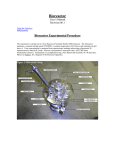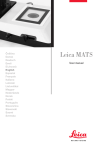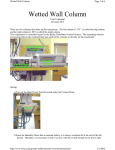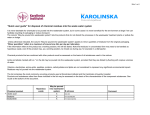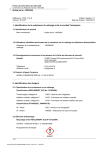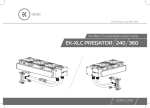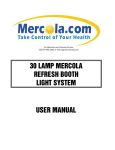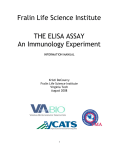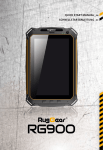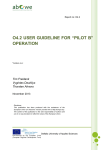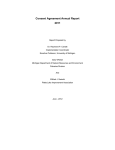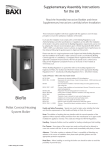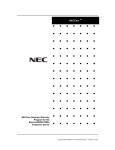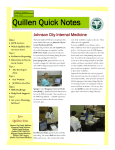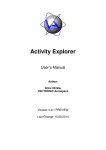Download Bioreactor Experimental Procedure
Transcript
Bioreactor Manual Page 1 of 4 Bioreactor User's Manual Revision 00.2 Using the autoclave Making media Glocuse (HK) Directions Bioreactor Experimental Procedure Note: Please see Mike Beliveau or the lab T.A.before attempting any portion of this lab. The yeast cultivation/experimentation is carried out in a New Brunswick Scientific Bioflo 3000 reactor provided by the Eastman Chemical Company of Kingsport, Tennessee.The bioreactor maintains a constant amount of oxygen dissolved in the media, a constant temperature (30E Celsius), and the pH above 4.0.All spectroscopic readings are taken using a Spectronic 21 manufactured by Bausch & Lomb.Glucose samples are incubated using a Lauda water bath.A diagram of the bioreactor apparatus is presented in Figure 1. Figure 1 – Bioreactor setup. Preparation of Reactor Media Note:To begin the experiment, the media must be made one or two days prior to starting the experiment.This is done to allow time to sterilize the media in the autoclave and allow it to return to room temperature. The reactor media used for each experimental run is prepared in the following manner: A dry mass is prepared in an eight-liter polypropylene container by adding the amount of each material according to Table 1. Ingredient Glucose - C6H12O6 Table 1 - Reactor Media Ingredients Amount 50 g Yeast Extract Ammonium Sulfate - (NH4)2SO4 7.5 g 24 g Potassium Phosphate Monobasic - KH2PO4 3.75 g Magnesium Sulfate Heptahydrate - MgSO4 * 7H2O 1.2 g Calcium Chloride Dihydrate - CaCl2 * 2H2O 0.18 g Five liters of distilled water are then added to the dry mass in the container and mixed.The entire mixture is then autoclaved for sterility.This media must be refrigerated until time of use.Also, 2.5 g of yeast is measured out and refrigerated until time of use. Data and Sample Collection Note:The media and yeast are added to the bioreactor three hours before lab time, so that the yeast mass will have grown a good amount before takingthe required measurements. Note:At the beginning of each lab period, the spectrometer and water bath must be turned on.The water bath must be set at 30E Celsius and given at least five minutes to warm up. http://www.et.byu.edu/groups/uolab/manuals/bioreactor/manual.html 3/1/2004 Bioreactor Manual Page 2 of 4 HK 50 AssayKit Preparation: See Bioreactor setup on UO lab web site. The bioreactor is filled with media, and a small sample of media is retained for later use as a spectroscopic blank.The media is then inoculated with the 2.5 g of yeast and the bioreactor turned on. Add one or two drops of antifoam agent at startup and whenever needed throughout the experiment. After the bioreactor has operated for three hours, two data series of dissolved oxygen concentrations are collected.First, the oxygen (air) supply is cut off and nitrogen gas is purged into the the reactor head space.This will prevent the oxygen from reentering the media sample. The Dissolved Oxygen concentration is then recorded off the digital display every ten seconds until it falls just below 35% of the initial concentration. The sample is now taken and the airflow is turned back on. The Dissolved Oxygen concentration is recorded every ten seconds until it reaches its original, steady-state value. Right after the Dissolved Oxygen concentration falls below 35% and before the air is turned on again, samples of the yeast media must be collected.These samples are taken to determine yeast and glucose concentrations, and correspondingly, the specific oxygen uptake and glucose consumption rates.Samples are taken as follows: $A collection bottle should be attached to the reactor before starting the data collection (Dissolved Oxygen concentration). $Once the Dissolved Oxygen concentration is below 35% of the initial value, the collection bottle valve is opened. $The attached bulb is squeezed to obtain a 2 ml sample. $The collection bottle valve is then closed. $This can be repeated if more media is needed Yeast Analysis A yeast blank is prepared by filling a 2-ml cuvette with the original media at 30°C without the yeast.When filling cuvettes, the liquid level must be high enough (about two-thirds full) for light to pass through it, and not air. Clean the optical window of the cuvette with Kim wipes.The spectrophotometer was then calibrated by inserting the deionized water blank and setting the zero at 660 nm by turning the dial until the meter reads 0 absorbance.Cuvettes must be inserted so that light from the spectrophotometer passes through the sample with the optical window facing the wavelength dial.The yeast blank is then inserted and the absorbance is recorded. Another 2 ml cuvette is filled with unfiltered sample from the bioreactor and placed in the spectrophotometer (this is done for each sample taken throughout the experiment).The absorbance and is measured and recorded. The absorbance obtained from the yeast blank will be subtracted from the absorbance obtained from each media sample. Note:If the absorbance is greater than 0.75, 1 ml of sample is diluted with 1 ml of distilled water and reanalyzed. Absorbance readings must then be multiplied by a factor of two to obtain the actual absorbance. Glucose Analysis The glucose analysis blank is prepared by adding 50 ml of distilled water to the Glucose (HK) 50 bottle.The mixture is gently inverted (not shaken) to dissolve the glucose powder into solution.Calibrate using deionized water at 30°C set at 340 nm.A reduced volume cuvette filled with 1 ml of the Glucose (HK) 50 solution and 0.01 ml of distilled water (using a micro pipette) is used as the blank for the glucose analysis.The absorbance of the blank is measured and recorded. Each glucose sample is now prepared as follows: $A reduced volume cuvette is filled with 1.0 ml of Glucose (HK) 50 reagent. $Approximately 1 ml of yeast sample is filtered with an 8 mm filter attached to a needle. $The filtered yeast sample is then placed in a test tube.0.01 ml is drawn off with a micro pipette and placed into the cuvette with the Glucose (HK) 50 reagent. (Do not allow the drop of sample to touch the sides of the cuvette). $The cuvette is covered with parafilm and inverted gently. $The cuvette is then placed in the water bath for 5 to 10 minutes prior to measuring the absorbance to allow the sample to incubate. This sample is good for 60 minutes. http://www.et.byu.edu/groups/uolab/manuals/bioreactor/manual.html 3/1/2004 Bioreactor Manual Page 3 of 4 Note:Again, if the absorbance measures more than above 0.75, the original, filtered sample must be dilluted with 1 ml of distilled water before reanalyzing it. The above procedure is repeated until about five data samples are taken and recorded. Bioreactor Setup Procedures The steps for the setup of the bioreactor are as follows: 11.Carefully remove the bioreactor from the autoclave and pour the water into the sink. Remove the mixer shaft cover from the top of the reactor cover 12.Properly align the reactor on the apparatus and add the reactor media. Then place the top cover into the reactor vessel so that the media collection device is pointed out from the apparatus.Once the top cover is in place, firmly tighten the screws. 13.Attach the two water fittings located toward the bottom of the reactor vessel and the two water fittings located on the top piece attached to the condensor of the apparatus 14.Place the mixer motor from the top of the apparatus onto the top of the reactor 15.Carefully remove the pH probe from the KCl solution and place it into the reactor 16.Carefully remove the dissolved oxygen probe from the deionized water and place into the reactor 17.Add 10 cc of water into the temperature well and then place the temperature sensor into the reactor 18.Carefully attach the NaOH feed into the proper port 19.Attach the Nitrogen purger into the proper port 20.Attach the Air sparger into the proper port 21.Place the filter on the top of the condensor 22.Attach the bulb onto the media collection device The steps for turning on the bioreactor are as follows: 23.Turn on the cooling water with the valve located by the sink 24.Turn on the air with the valve located on the side of the apparatus 25.Turn on the power to the apparatus The following steps deal with the turning on the controls of the experiment through the use of the electronic screen located on the front of the apparatus. 26.Turn on the temperature control to prime. 27.Turn on the pH control to PID control. The set point should be 4.0 28.Turn on the agitation control to PID control. The set point should be 350 rpm 29.Turn the temperature control to PID control. The set point should be 30 °C 30.Leave the control to the dissolved Oxygen off The steps for the clean up of the bioreactor are as follows: 31.Turn the agitator control to agitate.Then turn the control to off 32.Turn the temperature and pH controls to off 33.Turn the air off 34.Turn the apparatus off 35.Turn the cooling water off 36.Remove the mixer motor from the top of the reactor and place on top of the apparatus 37.Carefully remove the pH probe and place in the KCl solution 38.Carefully remove the Dissolved Oxygen probe and place in the deionized water 39.Remove the temperature sensor 40.Remove the filter from the condensor and the nitrogen purge and air sparge from the ports 41.Remove the water feeds starting with the bottom while placing a beaker to catch the excess water. Remove the top water feeds 42.Place the reactor vessel on a cart and take to the wet lab 43.Remove the cover and wash thoroughly with soap and water and rinse with deionized water. Place http://www.et.byu.edu/groups/uolab/manuals/bioreactor/manual.html 3/1/2004 Bioreactor Manual Page 4 of 4 the cover on the table so that it will not roll off 44.Pour the reactor media into the sink and wash thoroughly.Rinse the vessel with deionized water and then fill about 1/3 full of deionized water 45.Place back on the cart and attach cover. Attach screws but do not tighten Warning: The NaOH and KCl solutions are highly concentrated and must be handled with caution.Safety protection must be worn. The following steps are to be done by using the autoclave 46.Check the steam collection bottle to be sure that the level is between low and high 47.Remove the baskets and check the level of the water at the bottom of the autoclave. The water level is to be visible through the hole in the bottom plate but not above the plate 48.Place one basket in the autoclave 49.Place glass wool in the media collection port.Then place tin foil over any other ports. 50.Turn the media collection device and the condensor inward and place the reactor in the autoclave 51.Close the lid and tighten. Then place the magnet on the safety switch 52.Check the exhaust valve to be closed and temperature should be set to 121 °C 53.Turn on autoclave. http://www.et.byu.edu/groups/uolab/manuals/bioreactor/manual.html 3/1/2004




